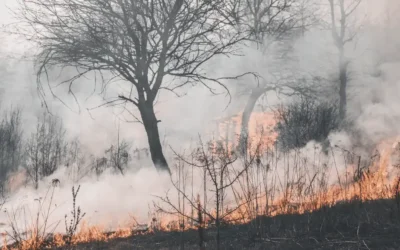By Kylin Cummings, Director of Collections
Thanksgiving Point was established in 1995 as a gift from Alan Ashton to his wife Karen to show gratitude for the community and the natural world. It has five discovery venues including the Mountain America Museum of Ancient Life, which was opened in 2001 as the second venue on the property.
The museum houses 60 complete dinosaur cast skeletons, including some rare and important specimens in the field of palaeontology making it home to one of the largest collections of mounted dinosaurs on view in the world.
Conceptualized as an immersive museum with various degrees of interactive hands-on displays throughout means that many of our exhibits were not built with adequate barriers or any barriers at all.
The Conserv Preventive Conservation Award funding was applied toward the purchase of materials to create a custom glass barrier to enclose a vulnerable Permian diorama in the museum. This was a critical project that improved the security of our artifacts and the experience of our guests.

Permian Diorama before the addition of the protective barriers. Image Courtesy of The Mountain America Museum of Ancient Life – Thanksgiving Point Institute.
Receiving this award excited both our exhibits team and management who decided to commit additional funding into the project, allowing us to pursue a tempered glass option instead of the polycarbonate which would have required replacement due to wear and tear from our guests.
The Permian Diorama At The Mountain America Museum Of Ancient Life
Our most vulnerable diorama where we see repeat damage and unwanted interaction consists of casts/sculpted reconstructions of a dicynodont, dimetrodon, and three eryops placed on a platform that happens to be the same height as our seating throughout the museum.
The dicynodont has seen extensive damage most notably when a toddler climbed onto the platform of the diorama and sat on it which instantly crushed it into pieces.

Damaged Dicynodont after exciting visitor interaction. Image Courtesy of The Mountain America Museum of Ancient Life – Thanksgiving Point Institute.
Additional damage we have often observed in this diorama is on the tail of the dimetrodon. It has been repeatedly broken to the point where we have had to recreate the pieces. The eryops have been mostly safe because they are made of a much sturdier material, polyester resin. The other two are made of a water extended polymer.

Dicynodont reconstruction after required restoration. Image Courtesy of The Mountain America Museum of Ancient Life – Thanksgiving Point Institute.
How Do You Install A Barrier To Protect A Large, Open Diorama?
In May 2023, the exhibits team got to work in finalizing the design and sourcing materials. We ultimately decided to spend a little more and get the ½” tempered glass. The hardware needed to be installed along the edge of the platform which meant some removal and reconstruction of the substrate needed to be performed. Here are the steps the exhibits team completed:
- Removal of old textured concrete, clean and prep substrate surface to correctly brace to the structure of the base platform.
- Prep and mark out supports and substrates to receive hardware and glass.
- Install glass and all hardware parts according to the manufacturer’s instructions of the interior glass wall assembly.
- Correct and align the level of the new glass wall. Also, confirm glass is level and plumb. Adjust all dividing glass panels as well as glass mounting hardware.
- Apply new color dyed concrete on the substrate.

The Permian diorama during installation of new protective barriers. Image Courtesy of The Mountain America Museum of Ancient Life – Thanksgiving Point Institute.
Results and Procedures For The Future
This project helped to make our desire to protect our collection while on exhibit a reality. The Conserv Preventive Conservation Award was the push our staff needed to accomplish this goal.
Now our exhibits team has experience and an established procedure for how to build barriers that easily adapt to the existing exhibits as well as how to plan for them when redesigning new exhibits.

The new tempered glass barrier protecting the Permian diorama inhabitants. Image Courtesy of The Mountain America Museum of Ancient Life – Thanksgiving Point Institute.
Improving and adding barriers in all our exhibits is now being included in our overall re-development of our exhibits and narrative for the Mountain America Museum of Ancient Life.
If you have any questions about environmental monitoring, integrated pest management, or just want to talk about preventative conservation for museums, please reach out to us! Don’t forget to check out our blog or join our community of collections care professionals where you can discuss hot topics, connect with conservators or even take a course to get familiar with the Conserv platform.




